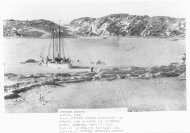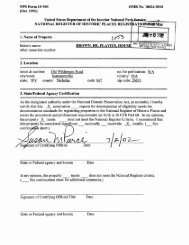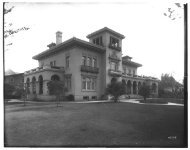National Register of Historic Places Registration Form
National Register of Historic Places Registration Form
National Register of Historic Places Registration Form
You also want an ePaper? Increase the reach of your titles
YUMPU automatically turns print PDFs into web optimized ePapers that Google loves.
NPS <strong>Form</strong> 10-900-a OMB Approval No. 10244018<br />
(M6)<br />
United States Department <strong>of</strong> the Interior<br />
<strong>National</strong> Park Service<br />
<strong>National</strong> <strong>Register</strong> <strong>of</strong> <strong>Historic</strong> <strong>Places</strong><br />
Continuation Sheet<br />
CLEVELAND PARK HISTORIC DISTRICT<br />
WASHINGTON D.C.<br />
Section number 8 Page 35<br />
The Broadmoor is another example <strong>of</strong> the suburban style apartment house<br />
occupying a five acre site and constructed at the same time as Tilden Gardens.<br />
It differs in that it is a single structure which wraps around an expansive<br />
lawn creating a formal appearance, whereas Tilden Gardens represents the more<br />
informal picturesque merging <strong>of</strong> its six buildings with a romantic landscaping<br />
scheme. Both, however, are clothed in medieval revival styles, drawing their<br />
decorative elements from English buildings <strong>of</strong> the 16th- and 17th-centuries<br />
recalling the Tudor and Jacobean periods.<br />
Joseph Abel, the architect, is a native Washingtonian born in 1905 and<br />
still living nearby. He received his architectural degree from George<br />
Washington University. He served an apprenticeship with George Santmyers in<br />
the 1920's and then worked as a draftsman for Arthur B. Heaton. Later he<br />
formed several partnerships with Charles Dillon (Dillon and Abel), with Julian<br />
Berla (Berla and Abel), and finally with Jesse Weinstein (Abel and Weinstein).<br />
His career spanned a variety <strong>of</strong> stylistic and technological changes, and he<br />
attempted to stay on the forefront designing some <strong>of</strong> the earliest<br />
International Style buildings in Washington D.C. He was also an innovator in<br />
the area <strong>of</strong> apartment house design and in 1947 he published the book Apartment<br />
Houses with co-author Fred N. Severud who was responsible for the section on<br />
structural engineering. "In July <strong>of</strong> 1947, Progressive Architecture stated<br />
that Abel's name was synonymous with advanced apartment house design in<br />
Washington D.C. 1 One year later, the Architectural Forum praised Abel's<br />
striking apartment buildings which have done so much to raise design<br />
standards and awaken the public to the necessity for change.'" ''(Antoinette<br />
Lee, Landmark Application for the Governor Shepherd Apartment House, Feb. 4,<br />
1985)<br />
The Broadmoor is a familiar Cleveland Park landmark which signals the end<br />
<strong>of</strong> the commercial area and the beginning <strong>of</strong> a series <strong>of</strong> significant large<br />
apartment houses along Connecticut Avenue. Its extensive open space in front<br />
<strong>of</strong> the tall structure allows air and light to reach Connecticut Avenue thereby<br />
respecting its existence as an avenue <strong>of</strong> old world grace and charm.<br />
Sedgwick Gardens, designed by Mihran Mesrobian in 1931 for Max Gorin,<br />
president <strong>of</strong> the Southern Construction Company, represents the "Piece de<br />
resistance <strong>of</strong> Mesrobian's originality <strong>of</strong> plan and sculptural decoration"<br />
according to Caroline Mesrobian Hickman, an art historian (and Mesrobian's<br />
granddaughter), who has done extensive research on his architectural<br />
career.*(Caroline Mesrobian Hickman; "Mihran Mesrobian (1889-1975):<br />
Washington Architect;" Design Action; Vol2/Number3, May/June 1983, p. 4.)<br />
When this apartment house was completed in 1932 it quickly became known as the<br />
"Queen <strong>of</strong> Connecticut Avenue." It has an unusual plan which is uniquely well<br />
sited providing a very sumptuous and highly visible entrance at the corner <strong>of</strong><br />
Connecticut Avenue and Sedgwick Street and enabling all <strong>of</strong> the apartments to<br />
have ample light, ventilation ana good views. It is also very significant<br />
because <strong>of</strong> Mesrobian's design <strong>of</strong> the original ornamentation which incorporates<br />
Byzantine and Middle Eastern (Islamic) motifs into an overall Art Deco scheme.
















